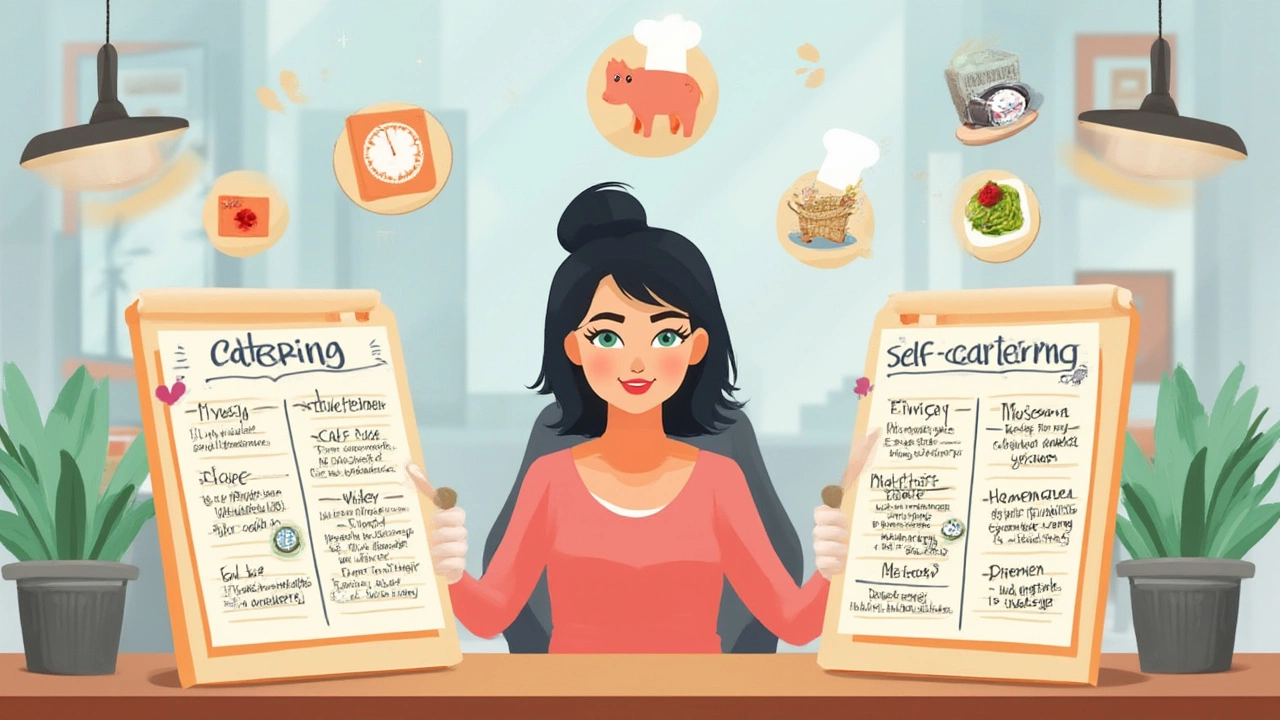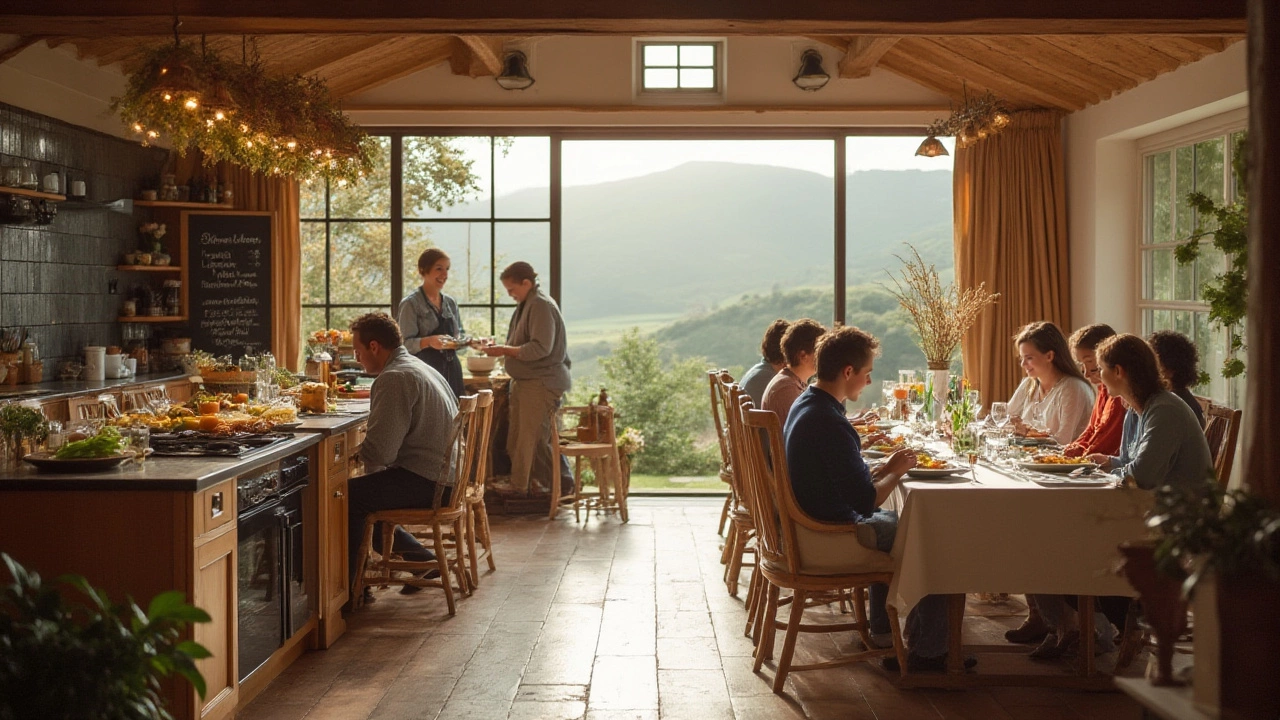Catering vs Self-Catering: Which Accommodation Is Right for Your Trip?
13 Jul, 2025Standing in a glossy hotel lobby, staring at a breakfast buffet with more pastries than a Parisian bakery, you might wonder—what exactly are you paying for? And what would it be like to swap this spread for a kitchen of your own, with sizzling bacon and fresh eggs just the way you like them? The lines are blurred; many people use “catering” and “self-catering” interchangeably when planning their trips, but there’s a world of difference that can totally change how you travel, eat, and chill. The choice between the structure (and sometimes pampering) of catering, and the freedom (and sometimes hassle) of self-catering, is pretty much the first fork in the road for anyone planning anything from a family getaway to a solo retreat. People often just pick out of habit or price, but the right pick can crank your trip up from just-okay to absolutely memorable.
Breaking Down Catering: What Are You Really Getting?
Catering sounds posh, doesn’t it? In the travel world, it simply means food and drink are provided as part of your accommodation. This can look like a hotel room with daily breakfasts, a resort where you don't ever have to pay out-of-pocket for anything extra (think ‘all-inclusive’), or even that charming B&B where Mary brings you a piping hot full-English in the morning. This is the place where you get to show up, sit down, and let someone else slice the bread—or maybe even the truffles—while you peruse the tea menu. Convenience is king here. You never have to hunt down the nearest supermarket for late-night snacks or worry about whether the tap water is safe. In many resorts, especially in the Mediterranean, Caribbean, and Southeast Asia, catering services can be highly elaborate, with international buffets, à la carte fine dining, and all manner of themed nights and entertainment. It’s a big reason why all-inclusive holidays are consistently one of the most popular travel options worldwide.
But let’s get real—the real pull isn’t just free food (though who’s turning down a bottomless pancake bar?). It’s the absolute absence of planning. When someone else worries about grocery shopping, prepping, cooking, or doing the dishes, your only task is to choose between scrambled and sunny-side up. For families, especially with little kids and picky eaters, this can be a lifesaver; you won’t have to face a meltdown in a supermarket aisle abroad. Older travelers or business people relish not having to wrangle over dietary needs or find late-night restaurants after meetings. And if you’re in an unfamiliar country, having local specialties cooked authentically for you can take the guesswork (and sometimes the risk) out of eating far from home.
But catering does come with trade-offs. Yes, it’s effortless, but you’re bound by someone else’s eating schedule—miss breakfast by five minutes, and you’re out of luck, or worse, eating whatever’s left (and nobody mourns an overcooked scrambled egg). Hotel or resort food is designed to please everyone, so it can sometimes feel a little bland. Folks with food allergies or special diets may find options frustratingly limited. And while you won’t be slaving over a stove, you’re likely paying a premium for this convenience. Pricing, tips, and those maddening ‘extras’—like a bottle of water or a side order of fries—can add up fast.
Self-Catering: The Taste of Freedom (and a Dash of Responsibility)
Ever wanted to cook fresh fish from the local market, or try your hand at a pasta dish after a stroll through a Tuscan vineyard? Self-catering means you’re in charge of your food: you shop, you cook, you eat on your own schedule. This is what you’ll get with a cottage in Cornwall, a city apartment in Barcelona, or an Airbnb in Cape Town. The term “self-catering” is really popular in the UK and Australia, but the concept is global. Vacation rentals, holiday homes, serviced apartments, and even some hostels use it—if you’ve got a fridge, stove, and a few pans to rattle around, you’re living the self-catering life.
This style suits adventurous eaters, bigger groups, or any traveler who wants to keep things flexible (and maybe frugal). You can cater to everyone’s tastes—literally. Got vegan teens, gluten-free friends, or a picky toddler who only eats buttered noodles? No sweat. You avoid the dreaded restaurant bills for every meal, and if you fancy a picnic at sunset or midnight ice cream in your pajamas, nobody’s stopping you. It’s no shock that self-catering is booming among digital nomads and long-term travelers who want to save cash, tap into local culture, and avoid feeling like just another guest in a sea of tourists.
But freedom has its own headaches. Someone still has to go grocery shopping, and maybe spend precious vacation time hunting down cumin in a small-town supermarket or deciphering ingredient labels in a new language. Daily cleanup? Yep, that’s on you, unless you pay for housekeeping. Not every self-catering spot is created equal: a “well-equipped kitchen” might mean a microwave and one dented frying pan. Planning meals can start to feel like a second job if you’re not prepared. So if the goal is real relaxation, make sure your group is on board with a little work—or a lot, depending on their appetite and culinary curiosity.

Weighing The Pros and Cons: What Matters Most To You?
The catering vs. self-catering debate sometimes sounds like luxury vs. adventure, or pampering vs. practicality, but it’s not always that simple. Different trips call for different setups—what works on a romantic getaway to Santorini might flop during a weeklong family reunion in the Lake District. Think about the real nuts and bolts that matter for accommodation choices: budget, flexibility, food preferences, group size, length of stay, and location.
- Budget: Catering almost always costs more up front, but factor in the cost of eating out if you go self-catering—especially in expensive destinations. Don’t forget hidden extras or required “minimum spends” in resorts.
- Flexibility: Self-catering wins for freedom of mealtimes and menus, while catering is perfect if you want structure or have a tight schedule packed with activities.
- Social Experience: Catered settings like hotels and all-inclusives can mean meeting new people, poolside games, or themed dinners (awkward dances to reggae bands, anyone?). Self-catering favors smaller, private groups—and more in-depth local market runs, if you’re game.
- Kids and Groups: Catering means less stress around meals, but self-catering lets you pick your own snacks and avoid those ‘she only eats applesauce’ moments. Self-catering's popularity with families isn’t just hype; it’s often the only way to avoid daily meltdowns.
- Diet and Allergies: If you’re vegan, have nut allergies, or just avoid certain foods, self-catering means total control. Some upmarket hotels can handle special diets with advance notice, but double-check ahead of time.
- Length of Stay: For longer trips, the savings and comfort of self-catering add up. Short city breaks? Catering can save time and work.
- Destination: Resorts in Mexico or the Maldives shine with all-inclusive catering—local food, unlimited drinks, no dishes. If you’re in a quiet village in France or Italy, though, self-catering opens up the chance to shop local and really experience a new culture.
It gets more nuanced the deeper you look. Did you know some self-catering spots now partner with local chefs for ‘in-villa’ dinners, or offer grocery delivery to your door? Some modern hotels blur the lines further: they’ll set you up with a kitchen but include a welcome breakfast and a few stocked drinks. The rise of hybrid options, where you can add a la carte meals or pay for professional cooks on demand, means there’s a lot more room to customize your experience now than even five years ago.
Tips For Choosing (And Making the Most of) Both Styles
Already picturing yourself with a croissant at a Paris hotel, or firing up the barbecue in your beach cottage? Planning is everything—but flexibility is just as key. Here are expert tips to make sure you don’t wind up with empty cupboards or cafeteria fatigue.
- Ask for Photos of Kitchens or Menus: Don’t rely on “well equipped”—get visuals of pots, pans, fridges, and layout. If catering, ask for menus ahead to spot any red flags for allergens, repeated dishes, or blandness.
- Scour the Fine Print: Some self-catering options sneak in crazy cleaning fees or rigid checkout times. Resorts may restrict meals to certain restaurants or limit ‘included’ drinks.
- Location, Location, Location: Self-catering in a remote villa means nobody’s delivering dinner at 10 p.m. Know your supermarket distances and opening hours, or check if meal delivery by local restaurants or grocers is offered. In urban hotels, check if room service or nearby eateries fill the gaps.
- Check Equipment and Extras: Coffee addicts? Not every self-catering flat comes with a real coffee maker (or even good mugs!).
- Watch the Weather: Rainy days in, say, an isolated Scottish cottage can hit hard if you haven’t stocked up. Catered spots often up their game during bad weather, keeping guests happy with themed meals or activities.
- Try a Split Stay: Can’t decide? Mix it up: start with catered luxury, finish with a laid-back self-catering rental. Some hotels even partner with villa owners to let you combine both.
- Get Social: Self-catering can leave you lonely, especially for solo travelers. Seek out communal meals in hostels, local food tours, or pop-up cooking classes for instant camaraderie.
- Be Realistic: If your vision of self-catering involves Gordon Ramsay-level meals, plan ahead. Bring or rent better knives, check for barbecue grills, and find local recipes to try. If your crowd can’t boil water without drama, set expectations (and maybe budget for takeout).
Your perfect trip might land anywhere along the catering–self-catering spectrum. Some travelers swear by the ease of full-board resorts and wouldn’t cook if you paid them. Others crave the challenge and joy of picking out local cheese at the morning market, settling around a kitchen table, and passing around stories. That’s the beauty of today’s travel landscape—whatever kind of meal you want, there’s a place to serve it, or a place where you can make it your own. Your stomach, your call.

 by
by